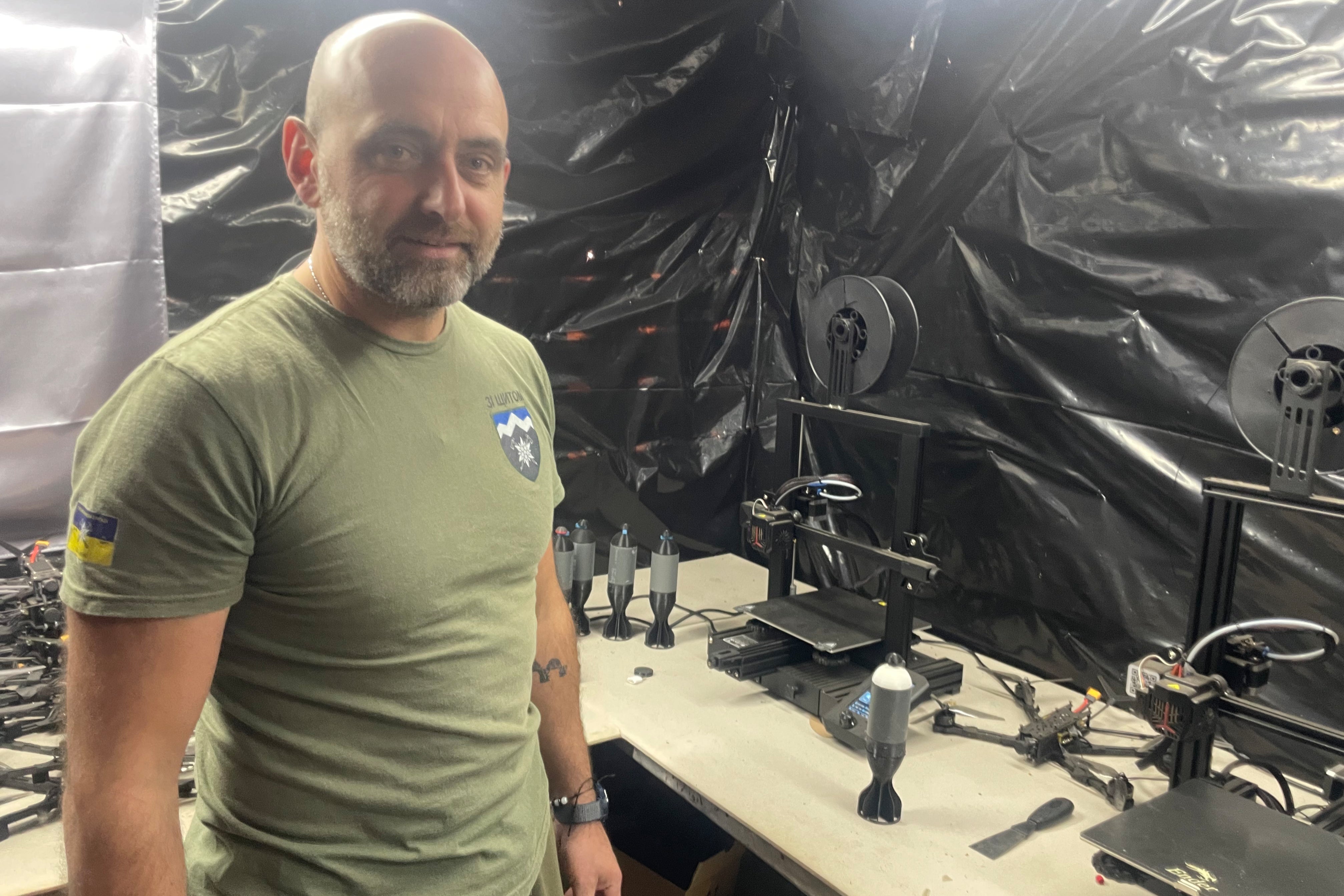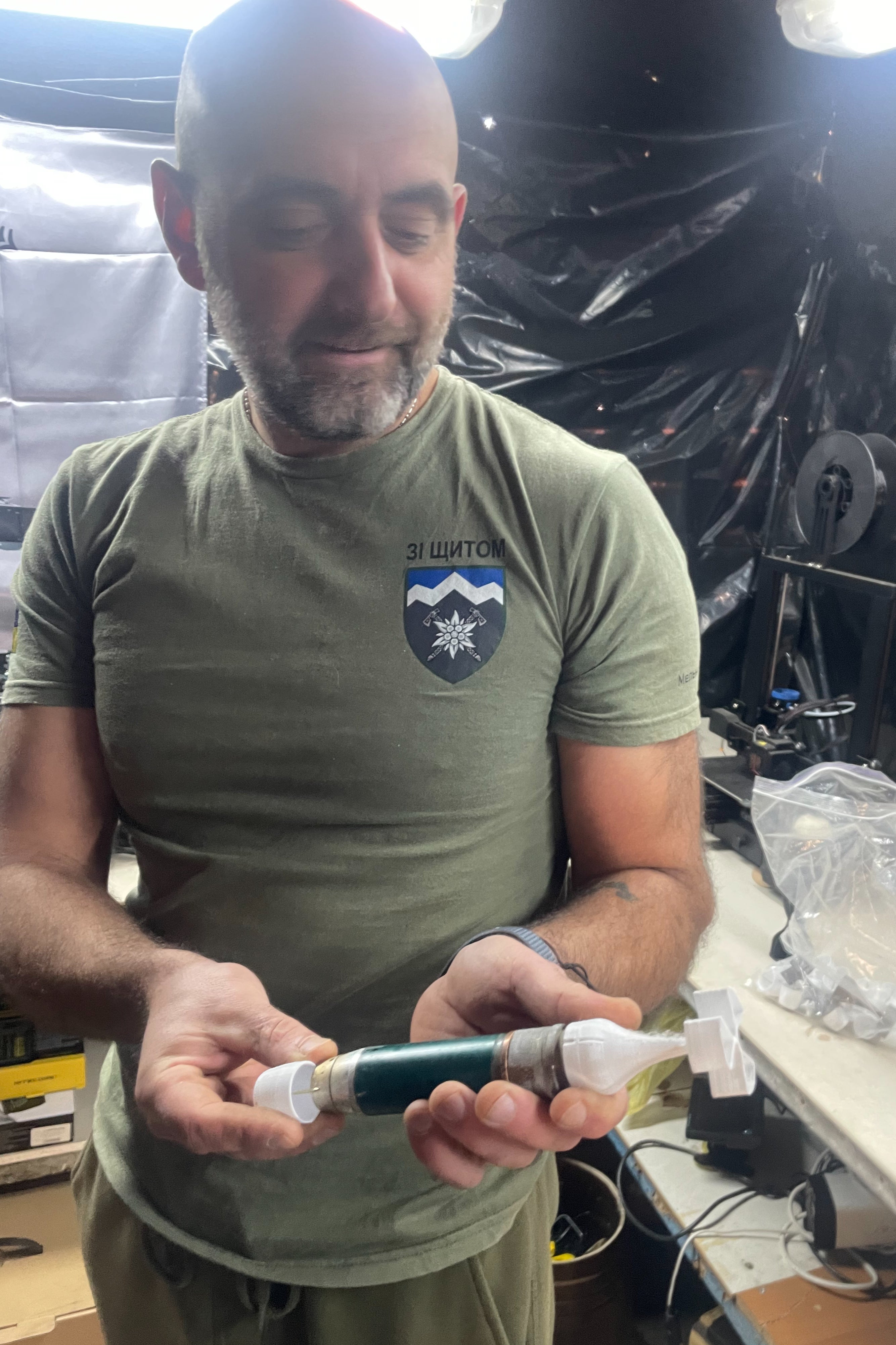Inside a frontline drone ‘laboratory’ creating new ways for Ukraine’s troops to hit Putin’s forces
As we reach the second anniversary of Russia’s invasion, Askold Krushelnycky meets members of a battalion in eastern Ukraine using 3D-printed explosive casings to build ‘bomber’ drones to take out artillery, armoured vehicles and tanks

Your support helps us to tell the story
From reproductive rights to climate change to Big Tech, The Independent is on the ground when the story is developing. Whether it's investigating the financials of Elon Musk's pro-Trump PAC or producing our latest documentary, 'The A Word', which shines a light on the American women fighting for reproductive rights, we know how important it is to parse out the facts from the messaging.
At such a critical moment in US history, we need reporters on the ground. Your donation allows us to keep sending journalists to speak to both sides of the story.
The Independent is trusted by Americans across the entire political spectrum. And unlike many other quality news outlets, we choose not to lock Americans out of our reporting and analysis with paywalls. We believe quality journalism should be available to everyone, paid for by those who can afford it.
Your support makes all the difference.Walking through the drone operators’ base, made up of buildings left standing amid the fierce fighting in a village near the town of Siversk in the eastern region of Donetsk, a soldier using the war name “Kucheryaviy” – Ukrainian for “Curly”, an ironic play on his shaved head – talks me through exactly how much explosive is required to take out an armoured vehicle with a “bomber” drone.
“We can fill them with more explosives, between 600 and 700 grams usually, enough to destroy or disable a light armoured vehicle. A tank is more difficult, but it can be done if the bomb is dropped in the right place. The explosive in anti-personnel versions can be surrounded by ball bearings or nails.”
As we walk, I notice that camouflage net coverings are draped across open walkways to prevent the base from being seen by the Russians. Drone operators on both sides of the war know they are each other’s new favourite target.
As Ukrainian and Russian forces have fought themselves to a grinding but bloody stalemate along most of the 600 miles of front lines, attention has increasingly shifted to the skies, with missiles, drones, air-defence systems and planes raining death down from above.
Unmanned aerial vehicles (UAVs) – commonly known as drones – have emerged as a priority for both Ukraine and Russia. For Ukraine, it is something they can craft and adapt that isn't reliant on help from the West. For a country outnumbered and outgunned by a far larger enemy, it is this innovation that is key to Kyiv surprising Vladimir Putin’s forces.
Drones are likely to dominate the next phase of the war, and a race is on to develop autonomous guidance systems, using artificial intelligence (AI) to make drones almost invulnerable to existing electronic warfare methods capable of disabling or destroying them.
For now, Curly, who worked for 22 years in the IT industry before volunteering for military service the day after Putin’s invasion began, works in what he calls his “laboratory”, experimenting with different types of explosive device that can either be released from expensive “bomber” drones, which can return intact after their mission, or strapped to “suicide” or “kamikaze” drones, which are destroyed when they smash into their targets.

They use 3D printers, as cheap as £800, to create plastic casings for different types of bomb. Curly says one casing can be printed every 24 hours.
“The drones can fly 12 to 13 kilometres, depending on how fast they are flown, the weight they carry, wind speed and direction and the temperature; the colder it is, the slower it is,” he explains.
“Much depends on the type of battery. We have modified drones with an extra battery. But that makes them a bit heavier, so you’re not doubling the flight distance.
“Because the 3D-printed bombs have lighter casings than the metal ones, we can fill them with more explosives.”
The Chinese “Mavic” brand of drone, which costs between £1,600 and £4,800, depending on such factors as whether it is fitted with a daytime camera or a more expensive night-time version, has become the most popular of those used by Ukraine.
Curly explains that last year, the Chinese manufacturers – probably at the behest of their Kremlin friends, he believes – introduced a tweak designed to prevent the drones from operating in Ukraine. But he says Ukrainian IT experts quickly found a way around that obstacle.
But, as ever more drones are used and each side gets better at destroying them, Ukrainians have searched around for cheaper options and quicker methods to replenish the inevitable losses.
The solution has been to make them, or as much of them as possible, domestically. Many of the components, though, have to be imported from abroad, and Ukrainians and Russians have been competing to buy up huge quantities of available parts from wherever they can be found.
Inside Curly’s “laboratory”, arrays of four-propeller “quadcopter” drones cover worktops. “Here we experiment how best to use what is available, and how to improve it or design new methods,” he says.
He adds that destroying enemy equipment is more important than using up a drone to hit a few men. But he says drones are used if a Russian human-wave assault threatens to overwhelm a Ukrainian position.

As Ukraine’s artillery-shell supply has become critically low, following a bitter dispute in the US Congress that has blocked military aid to Kyiv, drones have taken on tasks previously performed by the big guns.
This base Curly works from is operated by members of his 10th Independent Mountain Assault Brigade, defending, since the summer of 2022, around 20 miles of the most viciously contested front line threading through Ukraine. It is located in a mostly deserted village, where many of the houses have been reduced to rubble or charred skeletons by artillery and the one main road is cratered by shellfire and churned up by tanks and other heavy armoured vehicles, as well as trucks and ambulances sprinting to and from the front line.
Curly takes us round the base and into some of the remaining houses, which have rooms with banks of video screens showing images from cameras carried by the drones as they hunt for targets or attack their prey. Other rooms provide sleeping quarters.
A nearby field has metal hoops rigged up for drone operators to practise flying through or test out modified UAVs.
The main task of the base is to support the brigade’s artillery positions by spotting and destroying Russian artillery or howitzers that could target Ukrainian positions.
Until last year, the UAVs used in the conflict were relatively slow and guided by operators monitoring screens that showed images from the drones’ cameras.
Since last summer, they have been overtaken by “first person view” (FPV) drones, where the operator wears goggles allowing them to see directly through the UAV’s camera and thus guide it more precisely in real time.

This type of drone is more manoeuvrable and faster than the older varieties, can fly at around 60mph, and can go further – up to 15 miles, depending on conditions. Their pilots require more training to hone their skills.
The group of combat drone flyers introduced to The Independent are mostly young. They ask not to be photographed. Their leader, in his early twenties, sports a beard and a ponytail.
They have their own bases, with living quarters, storage and repair areas. Like Curly’s “laboratory”, they are usually behind the front line, but the pilots drive nearer to carry out their missions. To avoid being located and destroyed by the enemy tracking signals from their remote controls, the pilots, where possible, leave “repeaters” – devices that re-transmit those electronic signals to the drone but are hundreds of yards away from where the pilot is concealed.
As the importance of UAVs has increased, so have the countermeasures against them. Drones can be vulnerable to anti-air missiles or to marksmen using specialised large-calibre sniper rifles. Or even to ordinary machine guns.
However, shooting them down is an ineffective response to the huge number of small drones now being used by both sides against armoured vehicles, artillery, and missile and air-defence systems as well as soldiers on the move or in entrenchments.
The most efficient way to bring down a UAV guided by radio signals is to use electronic warfare (EW) techniques.
But here, too, Russia has an advantage, because it devoted much effort in the decade prior to its invasion of Ukraine to developing EW capabilities that allow operators to interfere with the GPS and remote-guidance control systems in Ukrainian UAVs, causing them to smash to the ground.

The UK’s Royal United Services Institute think tank has said Moscow’s EW capabilities allow it to destroy around 10,000 Ukrainian drones each month, and senior Ukrainian military officials have admitted that Russia’s EW expertise is currently still superior to that of Ukraine.
Curly says he has lost eight drones in recent days to Russian EW, but adds: “We are trying to catch up with Russia’s EW capabilities, and both sides are searching for new methods to disable or destroy the other side’s UAVs. Every hi-tech weapon or piece of equipment contains computerised components that, in theory, are vulnerable to interference and disruption by electronic means.”
Both Ukraine and Russia have developed compact EW devices that can be carried by tanks and other expensive hardware or installed in trenches and bunkers.
Ukraine last year finished trials on a rifle-like weapon that focuses disabling signals on approaching enemy drones.
Last autumn, Ukraine’s former military commander in chief, General Valery Zaluzhny, said the ground war had come to a deadlock reminiscent of that on First World War battlefields. He said that a “technological leap” comparable to the Chinese invention of gunpowder was likely to be needed to break the stalemate.
It seems almost certain that the next technological breakthrough will be designing an autonomous control and guidance system that can make swift and highly manoeuvrable drones less susceptible to electronic warfare.
This type of drone would be launched and initially operated by the pilot, who, from a distance, could choose a target and lock the drone onto it. Once the drone got this “fix”, its autonomous, artificial-intelligence-led control system would operate independently of the pilot, whose remote control apparatus, acutely vulnerable to EW, is the weakest link in existing drone missions.
Hence the autonomous drone could not be deflected by EW, and would continue on its path – and could even adjust its course to follow a moving target. Also, its pilot, for the initial launch, would need much less skill than the level required by current FPV pilots.
Ukraine’s minister for digital transformation, Mykhailo Fedorov, says that Ukrainian engineers are working on devising drone control systems with AI capability.
Ukrainians know Russians have devoted much effort to adapting AI for UAVs and are already experimenting with autonomous drones. Reflecting the importance his government attaches to producing vast quantities of UAVs, Ukrainian president Volodymyr Zelensky has announced Ukraine’s intention to produce one million drones this year. Kyiv’s allies have pledged to provide hundreds of thousands more.
For Curly, his goal is clear: “This war has turned into a race between us and the Russians to develop the most innovative, effective and destructive ways to use drones.”
Join our commenting forum
Join thought-provoking conversations, follow other Independent readers and see their replies
Comments